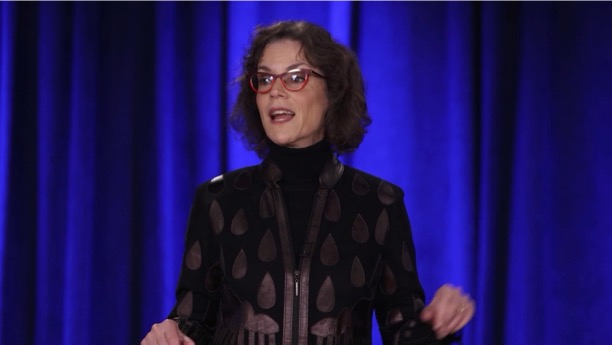
by Robyn Bolton | Nov 1, 2025 | Innovation, Leading Through Uncertainty
“Is this what the dinosaurs did before the asteroid hit?”
That was the first question I was asked at IMPACT, InnoLead’s annual gathering of innovation practitioners, experts, and service providers.
It was also the first of many that provided insight into what’s on innovators and executives’ minds as we prepare for 2026
How can you prevent failure from being weaponized?
This is both a direct quote and a distressing insight into the state of corporate life. The era of “fail fast” is long gone and we’re even nostalgic for the days when we simply feared failure. Now, failure is now a weapon to be used against colleagues.
The answer is neither simple nor quick because it comes down to leadership and culture. Jit Kee Chin, Chief Technology Officer at Suffolk Construction, explained that Suffolk is able to stop the weaponization of failure because its Chairman goes to great lengths to role model a “no fault” culture within the company. “We always ask questions and have conversations before deciding on, judging, or acting on something,” she explained
How do you work with the Core Business to get things launched?
It’s long been innovation gospel that teams focused on anything other than incremental innovation must be separated, managerially and physically, from the core business to avoid being “infected” by the core’s unquestioning adherence to the status quo.
The reality, however, is the creation of Innovation Island, where ideas are created, incubated, and de-risked but remain stuck because they need to be accepted and adopted by the core business to scale.
The answer is as simple as it is effective: get input and feedback during concept development, find a core home and champion as your prototype, and work alongside them as you test and prepare to launch.
How do you organize for innovation?
For most companies, the residents of Innovation Island are a small group of functionally aligned people expected to usher innovations from their earliest stages all the way to launch and revenue-generation.
It may be time to rethink that.
Helen Riley, COO/CFO of Google X, shared that projects start with just one person working part-time until a prototype produces real-world learning. Tom Donaldson, Senior Vice President at the LEGO Group, explained that rather than one team with a large mandate, LEGO uses teams specially created for the type and phase of innovation being worked on.
What are you doing about sustainability?
Honestly, I was surprised by how frequently this question was asked. It could be because companies are combining innovation, sustainability, and other “non-essential” teams under a single umbrella to cut costs while continuing the work. Or it could be because sustainability has become a mandate for innovation teams.
I’m not sure of the reason and the answer is equally murky. While LEGO has been transparent about its sustainability goals and efforts, other speakers were more coy in their responses, for example citing the percentage of returned items that they refurbish or recycle but failing to mention the percentage of all products returned (i.e. 80% of a small number is still a small number).
How can humans thrive in an AI world?
“We’ll double down,” was Rana el Kaliouby’s answer. The co-founder and managing partner of Blue Tulip Ventures and host of Pioneers of AI podcast, showed no hesitation in her belief that humans will continue to thrive in the age of AI.
Citing her experience listening to Radiotopia Presents: Bot Love, she encouraged companies to set guardrails for how, when, and how long different AI services can be used. She also advocated for the need for companies to set metrics that go beyond measuring and maximizing usage time and engagement to considering the impact and value created by their AI-offerings.
What questions do you have?

by Robyn Bolton | Oct 6, 2025 | 5 Questions, Customer Centricity, Innovation, Tips, Tricks, & Tools
For decades, we’ve faithfully followed innovation’s best practices. The brainstorming workshops, the customer interviews, and the validated frameworks that make innovation feel systematic and professional. Design thinking sessions, check. Lean startup methodology, check. It’s deeply satisfying, like solving a puzzle where all the pieces fit perfectly.
Problem is, we’re solving the wrong puzzle.
As Ellen Di Resta points out in this conversation, all the frameworks we worship, from brainstorming through business model mapping, are business-building tools, not idea creation tools.
Read on to learn why our failure to act on the fundamental distinction between value creation and value capture causes too many disciplined, process-following teams to create beautiful prototypes for products nobody wants.
Robyn: What’s the one piece of conventional wisdom about innovation that organizations need to unlearn?
Ellen: That the innovation best practices everyone’s obsessed with work for the early stages of innovation.
The early part of the innovation process is all about creating value for the customer. What are their needs? Why are their Jobs to be Done unsatisfied? But very quickly we shift to coming up with an idea, prototyping it, and creating a business plan. We shift to creating value for the business, before we assess whether or not we’ve successfully created value for the customer.
Think about all those innovation best practices. We’ve got business model canvas. That’s about how you create value for the business. Right? We’ve got the incubators, accelerators, lean, lean startup. It’s about creating the startup, which is a business, right? These tools are about creating value for the business, not the customer.
R: You know that Jobs to be Done is a hill I will die on, so I am firmly in the camp that if it doesn’t create value for the customer, it can’t create value for the business. So why do people rush through the process of creating ideas that create customer value?
E: We don’t really teach people how to develop ideas because our culture only values what’s tangible. But an idea is not a tangible thing so it’s hard for people to get their minds around it. What does it mean to work on it? What does it mean to develop it? We need to learn what motivates people’s decision-making.
Prototypes and solutions are much easier to sell to people because you have something tangible that you can show to them, explain, and answer questions about. Then they either say yes or no, and you immediately know if you succeeded or failed.
R: Sounds like it all comes down to how quickly and accurately can I measure outcomes?
E: Exactly. But here’s the rub, they don’t even know they’re rushing because traditional innovation tools give them a sense of progress, even if the progress is wrong.
We’ve all been to a brainstorm session, right? Somebody calls the brainstorm session. Everybody goes. They say any idea is good. Nothing is bad. Come up with wild, crazy ideas. They plaster the walls with 300 ideas, and then everybody leaves, and they feel good and happy and creative, and the poor person who called the brainstorm is stuck.
Now what do they do? They look at these 300 ideas, and they sort them based on things they can measure like how long it’ll take to do or how much money it’ll cost to do it. What happens? They end up choosing the things that we already know how to do! So why have the brainstorm?”
R: This creates a real tension: leadership wants progress they can track, but the early work is inherently unmeasurable. How do you navigate that organizational reality?
E: Those tangible metrics are all about reliability. They make sure you’re doing things right. That you’re doing it the same way every time? And that’s appropriate when you know what you’re doing, know you’re creating value for the customer, and now you’re working to create value for the business. Usually at scale
But the other side of it? That’s where you’re creating new value and you are trying to figure things out. You need validity metrics. Are we doing the right things? How will we know that we’re doing the right things.
R: What’s the most important insight leaders need to understand about early-stage innovation?
E: The one thing that the leader must do is run cover. Their job is to protect the team who’s doing the actual idea development work because that work is fuzzy and doesn’t look like it’s getting anywhere until Ta-Da, it’s done!
They need to strategically communicate and make sure that the leadership hears what they need to hear, so that they know everything is in control, right? And so they’re running cover is the best way to describe it. And if you don’t have that person, it’s really hard to do the idea development work.”
But to do all of that, the leader also must really care about that problem and about understanding the customer.
We must create value for the customer before we can create value for the business. Ellen’s insight that most innovation best practices focus on the latter is devastating. It’s also essential for all the leaders and teams who need results from their innovation investments.
Before your next innovation project touches a single framework, ask yourself Ellen’s fundamental question: “Are we at a stage where we’re creating value for the customer, or the business?” If you can’t answer that clearly, put down the canvas and start having deeper conversations with the people whose problems you think you’re solving.
To learn more about Ellen’s work, check out Pearl Partners.
To dive deeper into Ellen’s though leadership, visit her Substack – Idea Builders Guild.
To break the cycle of using the wrong idea tools, sign-up for her free one-hour workshop.

by Robyn Bolton | Sep 16, 2025 | Leading Through Uncertainty, Tips, Tricks, & Tools
When a project is stuck and your team is trying to manage uncertainty, what do you hear most often:
- “We’re so afraid of making the wrong decision that we don’t make any decisions.”
- “We don’t have time to explore a bunch of stuff. We need to make decisions and go.”
- “The problem is so multi-faceted, and everything affects everything else that we don’t know where to start.”
I’ve heard all three this week, each spoken by teams leads who cared deeply about their projects and teams.
Differentiating between risk and uncertainty and accepting that uncertainty would never go away, just change focus helped relieve their overwhelm and self-doubt.
But without a way to resolve the fear, time-pressure, and complexity, the project would stay stuck with little change of progressing to success.
Turn uncertainty into an asset
It’s a truism in the field of innovation that you must fall in love with the problem, not the solution. Falling in love with the problem ensures that you remain focused on creating value and agnostic about the solution.
While this sounds great and logically makes sense, most struggle to do it. As a result, it takes incredible strength and leadership to wrestle with the problem long enough to find a solution.
Uncertainty requires the same strength and leadership because the only way out of it is through it. And, research shows, the process of getting through it, turns it into an asset.
3 Steps to turn uncertainty into an asset
Research in the music and pharmaceutical industries reveals that teams that embraced uncertainty engaged in three specific practices:
- Embrace It: Start by acknowledging the uncertainty and that things will change, go wrong, and maybe even fail. Then stay open to surprise and unpredictability, delving into the unknown “by being playful, explorative, and purposefully engaging in ventures with indeterminate outcome.”
- Fix It: Especially when dealing with Unknowable Uncertainty, which occurs when more info supports several different meanings rather than pointing to one conclusion, teams that succeed make provisional decisions to “fix” an uncertain dimension so they can move forward while also documenting the rationale for the fix, setting a date to revisit it, and criteria for changing it.
- Ignore It: It’s impossible to embrace every uncertainty at once and unwise to fix too many uncertainties at the same time. As a result, some uncertainties, you just need to ignore. Successful teams adopt “strategic ignorance” “not primarily for purposes of avoiding responsibility [but to] allow postponing decisions until better ideas emerge during the collaborative process.
This practice is iterative, often leading to new knowledge, re-examined fixes, and fresh uncertainties. It sounds overwhelming but the teams that are explicit and intentional about what they’re embracing, fixing, and ignoring are not only more likely to be successful, but they also tend to move faster.
Put it into practice
Let’s return to NatureComp, a pharmaceutical company developing natural treatments for heart disease.
Throughout the drug development process, they oscillated between addressing What, Who, How, and Where Uncertainties. They did that by changing whether they embraced, fixed, or ignored each type of uncertainty at a given point:
![]()
As you can see, they embraced only one type of uncertainty to ensure focus and rapid progress. To avoid the fear of making mistakes, they fixed uncertainties throughout the process and returned to them as more information came available, either changing or reaffirming the fix. Ignoring uncertainties helped relieve feelings of being overwhelmed because the team had a plan and timeframe for when they would shift from ignoring to embracing or fixing.
Uncertainty is dynamic. You need to be dynamic, too.
You’ll never eliminate uncertainty. It’s too dynamic to every fully resolve. But by dynamically embracing, fixing, and ignore it in all its dimensions, you can accelerate your path to success.

by Robyn Bolton | Aug 4, 2025 | Leadership, Leading Through Uncertainty, Stories & Examples, Strategy
The best business advice can destroy your business. Especially when you follow it perfectly.
Just ask Johnny Cash.
After bursting onto the scene in the mid-1950s with “Folsom Prison Blues”, Cash enjoyed twenty years of tremendous success. By the 1970s, his authentic, minimalist approach had fallen out of favor.
Eager to sell records, he pivoted to songs backed by lush string arrangements, then to “country pop” to attract mainstream audiences and feed the relentless appetite of 900 radio stations programming country pop full-time.
By late 1992, Johnny Cash’s career was roadkill. Country radio had stopped playing his records, and Columbia Records, his home for 25 years, had shown him the door. At 60, he was marooned in faded casinos, playing to crowds preferring slot machines to songs.
Then he took the stage at Madison Square Garden for Bob Dylan’s 30th anniversary concert.
In the audience sat Rick Rubin, co-founder of Def Jam Recordings and uber producer behind Public Enemy, Run-DMC, and Slayer, amongst others. He watched in awe as Cash performed, seeing not a relic but raw power diluted by smart decisions.
The Stare-Down that Saved a Career
Four months later, Rubin attended Cash’s concert at The Rhythm Café in Santa Anna, California. According to Cash’s son, “When they sat down at the table, they said: ‘Hello.’ But then my dad and Rick just sat there and stared at each other for about two minutes without saying anything, as if they were sizing each other up.”
Eventually, Cash broke the silence, “What’re you gonna do with me that nobody else has done to sell records for me?”
What happened next resurrected his career.
Rubin didn’t promise record sales. He promised something more valuable: creative control and a return to Cash’s roots.
Ten years later, Cash had a Grammy, his first gold record in thirty years, and CMA Single of the Year for his cover of Nine Inch Nails’ “Hurt,” and millions in record sales.
When Smart Decisions Become Fatal
Executives do exactly what Cash did. You respond to market signals. You pivot your offering when customer preferences shift and invest in emerging technologies.
All logical. All defensible to your board. All potentially fatal.
Because you risk losing what made you unique and valuable. Just as Cash lost his minimalist authenticity and became a casualty of his effort to stay relevant, your business risks losing sight of its purpose and unique value proposition.
Three Beliefs at the Core of a Comeback
So how do you avoid Cash’s initial mistake while replicating his comeback? The difference lies in three beliefs that determine whether you’ll have the creative courage to double down on what makes you valuable instead of diluting it.
- Creative confidence: The belief we can think and act creatively in this moment.
- Perceived value of creativity: Our perceived value of thinking and acting in new ways.
- Creative risk-taking: The willingness to take the risks necessary for active change.
Cash wanted to sell records, and he:
- Believed that he was capable of creativity and change.
- Saw the financial and reputational value of change
- Was willing to partner with a producer who refused to guarantee record sales but promised creative control and a return to his roots.
Your Answers Determine Your Outcome
Like Cash, what you, your team, and your organization believe determines how you respond to change:
- Do I/we believe we can creatively solve this specific challenge we’re facing right now?
- Is finding a genuinely new approach to this situation worth the effort versus sticking with proven methods?
- Am I/we willing to accept the risks of pursuing a creative solution to our current challenge?”
Where there are “no’s,” there is resistance, even refusal, to change. Acknowledge it. Address it. Do the hard work of turning the No into a Yes because it’s the only way change will happen.
The Comeback Question
Cash proved that authentic change—not frantic pivoting—resurrects careers and disrupts industries. His partnership with Rubin succeeded because he answered “yes” to all three creative beliefs when it mattered most. Where are your “no’s” blocking your comeback?

by Robyn Bolton | Jul 16, 2025 | Leadership, Strategic Foresight
You’ve done everything to set Strategic Foresight efforts up for success. Executive authority? Check. Challenging inputs? Check. Process integration? Check. Now you just need to flip the switch and you’re off to the races.
Not so fast.
While the wrong set-up is guaranteed to cause failure, the right set-up doesn’t guarantee success. Research shows that strategic foresight initiatives with the right set-up fail because of “organizational pathologies” that sabotage even well-designed efforts.
If you aren’t leading the right people to do the right things in the right way, you’re not going to get the impact you need.
Here’s what to watch out for (and what to do when it happens).
Your Teams Misunderstand Foresight’s Purpose
People naturally assume that strategic foresight predicts the future. When it doesn’t, they abandon it faster than last year’s digital transformation initiative.
Shell learned this the hard way. In 1965, they built the Unified Planning Machinery, a computerized forecasting tool designed to predict cash flow based on trends. It was abandoned because executives feared “it would suppress discussion rather than encourage debate on differing perspectives.”
When they shifted from prediction to preparation, specifically to “modify the mental model of decision-makers faced with an uncertain future,” strategic foresight became an invaluable decision-making tool.
Help your team approach strategic foresight as preparation, not prediction, by measuring success by the improvement in discussion and decision-making, not scenario accuracy. When teams build mental flexibility rather than make predictions, wrong scenarios stop being failed scenarios.
People are Paralyzed by Fear of Being Wrong
Even when your teams understand foresight’s purpose, managers are often unwilling “to use foresight to plan beyond a few quarters, fearing that any decisions today could be wrong tomorrow.”
This is profoundly human. As Webb wrote, “When faced with uncertainty, we become inflexible. We revert to historical patterns, we stick to a predetermined plan, or we simply refuse to adopt a new mental model.” We nod along in scenario sessions, then make decisions exactly like we always have.
Shell’s scenario planning efforts succeeded because it made being wrong acceptable. Even though executives initially scoffed at the idea of oil prices quadrupling, they prepared for the scenario and took near-term “no regrets” decisions to restructure their portfolio.
To help people get past their fear, reward them for making foresight-informed decisions. For example, establish incentives and promotion criteria where exploring “wrong” scenarios leads to career advancement.
Your Culture Confuses Activity with Achievement
Between insight and action, the Tyranny of Now reigns. In even the most committed organizations, the very real and immediate needs of the business call us away from our planning efforts and consume our time and energy, meaning strategic foresight is embraced only when it doesn’t interfere with their “real” jobs.
Disney’s approach made strategic foresight a required element of people’s “real jobs” by integrating foresight activities and insights directly into performance management and strategic planning. When foresight teams identified that traditional media consumption was fracturing in 2012, Disney began preparing for that future by actively exploring and investing in new potential solutions.
Resist the Tyranny of Now’s pull by making strategic foresight activities just as tyrannical – require decisions based on foresight insights to occur in 90 days or less. These decisions should trigger resource allocation reviews, even if the resources are relatively small (e.g., one or a few people, tens or hundreds of thousands of dollars). If strategic foresight doesn’t force hard choices about investments and priorities, it’s activity without achievement.
How You Lead and What People Do Determine Strategic Foresight’s Success
Executive authority, challenging inputs, and process integration are necessary but not sufficient. Success requires conquering the deeper organizational and human behaviors that determine whether strategic foresight is a corporate ritual or a competitive advantage.




